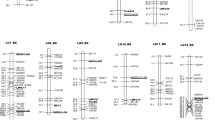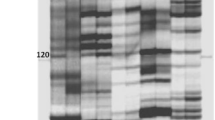Abstract
Genetic male sterility (GMS) has been a useful system for the production of hybrid varieties in self-pollinated plants. We obtained a GMS line developed from a spontaneous mutation in lettuce (Lactuca sativa L.). Genetic analysis in our previous study revealed that the sterility was controlled by a recessive gene which was named ms-S. For simple and quick screening of individuals showing male sterility, we attempted molecular mapping of the ms-S locus using an amplified fragment length polymorphism (AFLP) technique. From the examination of 4,096 AFLP primer combinations, 63 AFLP markers were found to be linked to the gene and nine of them were successfully converted into sequence characterized amplified region (SCAR) markers and cleaved amplified polymorphic sequence (CAPS) markers. Linkage analysis indicated that these nine markers were closely linked to the ms-S gene and all were located on the same side of the gene. The minimum genetic distance between the ms-S gene and a marker was 3.1 cM. These results provide additional information for map-based cloning of the ms-S gene and will be of great help for lettuce breeding using GMS to produce F1 hybrids.


Similar content being viewed by others
References
Chen J, Hu J, Vick BA, Jan CC (2006) Molecular mapping of a nuclear male-sterility gene in sunflower (Helianthus annuus L.) using TRAP and SSR markers. Theor Appl Genet 113:122–127
Dogget H (1972) Recurrent selection in Sorghum populations. Heredity 28:9–29
Dovora L, Frankel R (1961) Practical aspects and the use of male sterility in the production of hybrid tomato seed. Euphytica 16:300–310
Doyle JJ, Doyle JL (1987) A rapid DNA isolation procedure for small quantities of flesh leaf tissue. Phytochem Bull 19:11–15
Farrara B, Hott TW, Michelmore RW (1987) Genetic analysis of factors for resistance to downy mildew (Bremia lactucae) in lettuce (Lactuca sativa). Plant Pathol 36:499–514
Goubara M, Takasaki T (2004) Pollination effect of the sweet bee Lasioglossum villosulum trichopse (Hymenoptera: Halictidae) on genic male-sterile lettuce. Appl Entomol Zool 39:163–169
Hayashi M, Miyahara A, Sato S, Kato T, Yoshikawa M, Taketa M, Hayashi M, Pedrosa A, Onda R, Imaizumi-Anraku H, Bachmair A, Sandal N, Stougaard J, Murooka Y, Tabata S, Kawasaki S, Kawaguchi M, Harada K (2001) Construction of a genetic linkage map of the model legume Lotus japonicus using an intraspecific F2 population. DNA Res 8:301–310
Hockett EA, Eslick RF (1970) Genetic male sterile genes useful in hybrid barley production. In: Nilan RA (ed) Barley genetics II. Washington State University Press, Pullman, pp 298–307
Hubbard JC, Gerikj JS (1993) New wilt disease of lettuce incited by Fusarium oxysporum f. sp. lactucum forma specialis nov. Plant Dis 77:750–755
Konieczny A, Ausubel F (1993) A procedure for mapping Arabidopsis mutations using co-dominant ecotype-specific PCR based markers. Plant J 4:403–410
Kosambi DD (1944) The estimation of map distances from recombination value. Ann Eugene 12:172–175
Kuwata S, Kubo S, Yamashita S, Doi Y (1983) Rod-shaped particles, a probable entity of lettuce big vein virus. Ann Phytopathol Soc Jpn 49:246–251
Langton FA, Smith JWM, Edmondson RN (1990) Heterosis in crisphead lettuce (Lactuca sativa L.) hybrids. Euphytica 49:15–23
Michelmore RW (2009) California leafy greens research program. http://calgreens.org/control/uploads/Genetic_Variation_in_Lettuce_-_Michelmore.pdf
Michelmore RW, Paran I, Kesseli RV (1991) Identification of markers linked to disease-resistance genes by bulked segregant analysis: a rapid method to detect markers in specific genomic regions by using segregating populations. Proc Natl Acad Sci USA 88:9828–9832
Mienie CMS, Liebenberg MM, Pretorius ZA, Miklas PN (2005) SCAR markers linked to the common bean rust resistance gene Ur-13. Theor Appl Genet 111:972–979
Neff MM, Neff JD, Chory J, Pepper AE (1998) dCAPS, a simple technique for the genetic analysis of single nucleotide polymorphisms: experimental applications in Arabidopsis thaliana genetics. Plant J 14:387–392
Paran I, Michelmore RW (1993) Development of reliable PCR-based markers linked to downy mildew resistance genes in lettuce. Theor Appl Genet 85:985–993
Robinson RW, McCreight JD, Ryder EJ (1983) The genes of lettuce and closely related species. In: Janick J (ed) Plant breeding reviews, vol 1. Avi, Westport, pp 267–293
Rozen S, Skaletsky H (2000) Primer3 on the WWW for general users and for biologist programmers. In: Krawetz S, Misener S (eds) Bioinformatics methods and protocols in the series methods in molecular biology. Humana Press, Totowa, pp 365–386. Source code available at http://primer3.sourceforge.net/
Ryder EJ (1967) A recessive male sterility gene in lettuce (Lactuca sativa L.). Proc Am Soc Hortic Sci 91:366–368
Sasazaki S, Itoh K, Arimitsu S, Imada T, Takasuga A, Nagaishi H, Takano S, Mannen H, Tsuji S (2004) Development of breed identification markers derived from AFLP in beef cattle. Meat Sci 67:275–280
Tanksley SD, Young ND, Paterson AH, Bonierbale MW (1989) RFLP mapping in plant breeding: new tools for an old science. Biotechnology 7:257–264
Thomas CM, Vos P, Zebeau M, Jones DA, Norcott KA, Chardwick BP, Jones JDG (1995) Identification of amplified restriction fragment polymorphism (AFLP) markers tightly linked to the tomato Cf-9 gene for resistance to Cladosporium fulvum. Plant J 8:785–794
Tsuchiya N (2009) Chouya No. 37, a fusarium root rot (race2)-resistant lettuce. J Jpn Soc Hortic Sci 78:206–210
Tsuchiya N, Yoshida K, Usui T, Tsukada M (2004) ‘Shinano hope’, a fusarium root rot-resistant lettuce. J Jpn Soc Hortic Sci 73:429–434
Van Ooijen JW, Voorrips RE (2001) JoinMap 3.0, software for the calculation of genetic linkage maps. Plant Research International, Wageningen
Vos P, Hogers R, Bleeker M, Reijans M, van de Lee T, Hornes M, Freijters A, Pot J, Peleman J, Kuiper M, Zabeau M (1995) AFLP: a new technique for DNA fingerprinting. Nucleic Acids Res 23:4407–4414
Whitaker TW (1969) Salads for everyone—a look at the lettuce plant. Econ Bot 23:261–264
Zhang Y, Stommel JR (2001) Development of SCAR and CAPS markers linked to the Beta gene in tomato. Crop Sci 41:1602–1608
Acknowledgments
The work was partly supported by a grant, Research Project for Utilizing Advanced Technologies in Agriculture, Forestry and Fisheries, from the Ministry of Agriculture, Forestry and Fisheries, Japan.
Author information
Authors and Affiliations
Corresponding author
Rights and permissions
About this article
Cite this article
Hayashi, M., Ujiie, A., Serizawa, H. et al. Development of SCAR and CAPS markers linked to a recessive male sterility gene in lettuce (Lactuca sativa L.). Euphytica 180, 429–436 (2011). https://doi.org/10.1007/s10681-011-0417-y
Received:
Accepted:
Published:
Issue Date:
DOI: https://doi.org/10.1007/s10681-011-0417-y




